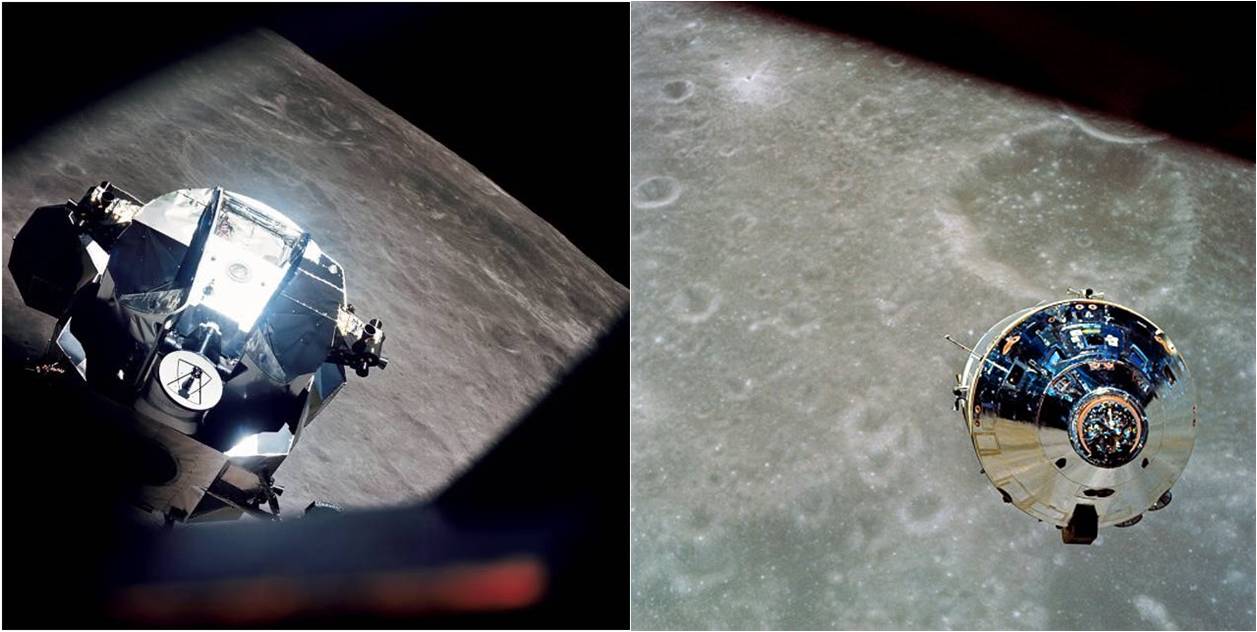Forty-one years ago this week, Apollo 10 set sail for the Moon on a mission that would see American astronauts fly within a mere 8 nautical miles of the lunar surface. This historic flight cleared the way for the first manned lunar landing just 2 months later.
The infamous Apollo 1 fire in January 1967 resulted in a 21-month suspension of manned spaceflight operations for the United States. By the time the first post-Apollo 1 flight occurred in October 1968, a scant 14 months remained for fulfillment of the national goal to land men on the Moon and return them safely to the Earth by the end of the 1960’s.
Not a few held the position that the lunar landing goal could not be achieved by the end of the decade. Some went so far as to say a successful lunar landing would never occur. Space program opponents had a field day. As always, these ever-present naysayers averred that the US should be spending its money on more “socially-important” programs.
Despite the undercurrents of pessimism and vacillation, NASA resolutely pressed forward. In October of 1968, the Apollo Command Module was thoroughly tested in Earth orbit during Apollo 7. Then, in December of 1968, the mighty Saturn V launch vehicle placed the crew of Apollo 8 in lunar orbit. Finally, the Lunar Module was successfully flight-tested by the Apollo 9 astronauts in March of 1969.
Incredibly, each of the key Apollo flight hardware had been individually tested during 3 missions that were flown over the course of 5 months. Now it was time to test them together. Enter Apollo 10. The purpose of Apollo 10 was to fly to the Moon and do everything short of an actual landing. Apollo 10 was thus a complete dress rehearsal for Apollo 11 sans the landing.
On Sunday, 18 May 1969, Apollo 10 lifted-off from Cape Canaveral’s LC 39B at 16:49 UTC. The crew consisted of Mission Commander Thomas P. Stafford, Command Module Pilot John W. Young and Lunar Module Pilot Eugene A. Cernan. Riding on 7.5 million pounds of first stage thrust, the Saturn V accelerated, went through 2 staging events and arrived in Earth orbit 12 minutes after lift-off.
Following systems checkout, the Saturn IVB third was re-ignited to start the translunar injection (TLI). Apollo 10 entered lunar orbit almost 76 hours after launch. The astronauts later circularized their orbit at 60 nautical miles and then rested in preparation for the next day’s lunar landing rehearsal.
At a mission elapsed time of 98 hours, the Apollo 10 Command and Lunar Modules undocked and separated from one another. Stafford and Cernan crewed the Lunar Module and while John Young flew alone in the Command Module. Over the next 18 hours the Lunar Module crew flew all the flight maneuvers and executed all the procedures associated with a lunar landing.
As planned, Stafford and Cernan did not land on the Moon. The closest approach to the lunar surface was approximately 8 nautical miles. The view was great and thoughts about landing were in the crew’s minds. In actuality, the Apollo 10 Lunar Module was not configured for a lunar landing. Had the crew attempted such, they would have been doomed.
The Lunar Module’s return to rendezvous and dock with the Command Module was unremarkable with the exception of staging. The crew mistakenly left the Abort Guidance System (AGS) in AUTOMATIC rather than ATTITUDE HOLD. At separation of the Ascent and Descent Stages, the Ascent Stage wildly gyrated and flirted with gimbal lock.
The crew quickly discovered the AGS switch position problem and brought the vehicle back into control. But it was pretty hairy there for a few moments. As Stafford and Cernan worked to steady their steed, both astronauts articulated their surprise and concern with the dire situation using colorful and interesting language not typically associated with refined behavior.
Happily, the trip back to Earth was nominal. Apollo 10 landed at 16:52 UTC in the Pacific Ocean on Monday, 26 May 1969. Their mission had been highly successful. The way was now clear for an actual lunar landing attempt. That opportunity came just 2 months later. History records that men landed on the Moon and safely returned to the Earth in July 1969.
John Young returned to and landed on the Moon as Commander of Apollo 16 in April of 1972. He went on to command the first Space Shuttle mission (STS-1) in April of 1981. Gene Cernan was Commander of Apollo 17 in December 1972 and was the last man to walk on the Moon. Tom Stafford never returned to the Moon. However, he served as Apollo Spacecraft Commander for the ASTP mission in July of 1975.

